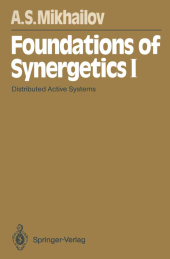 Neuerscheinungen 2012Stand: 2020-01-07 |
Schnellsuche
ISBN/Stichwort/Autor
|
Herderstraße 10
10625 Berlin
Tel.: 030 315 714 16
Fax 030 315 714 14
info@buchspektrum.de |

Alexander S. Mikhailov
Foundations of Synergetics I
Distributed Active Systems
2. Aufl. 2012. xii, 213 S. 12 SW-Abb. 235 mm
Verlag/Jahr: SPRINGER, BERLIN 2012
ISBN: 3-642-78558-1 (3642785581)
Neue ISBN: 978-3-642-78558-0 (9783642785580)
Preis und Lieferzeit: Bitte klicken
This book gives an introduction to the mathematical theory of cooperative behavior in active systems of various origins, both natural and artificial. It is based on a lecture course in synergetics which I held for almost ten years at the University of Moscow. The first volume deals mainly with the problems of pattern fonnation and the properties of self-organized regular patterns in distributed active systems. It also contains a discussion of distributed analog information processing which is based on the cooperative dynamics of active systems. The second volume is devoted to the stochastic aspects of self-organization and the properties of self-established chaos. I have tried to avoid delving into particular applications. The primary intention is to present general mathematical models that describe the principal kinds of coopera tive behavior in distributed active systems. Simple examples, ranging from chemical physics to economics, serve only as illustrations of the typical context in which a particular model can apply. The manner of exposition is more in the tradition of theoretical physics than of in mathematics: Elaborate fonnal proofs and rigorous estimates are often replaced the text by arguments based on an intuitive understanding of the relevant models. Because of the interdisciplinary nature of this book, its readers might well come from very diverse fields of endeavor. It was therefore desirable to minimize the re quired preliminary knowledge. Generally, a standard university course in differential calculus and linear algebra is sufficient.
1. Introduction.- 1.1 Basic Types of Distributed Active Systems.- 1.2 Engineering and Control of Active Systems.- 2. Bistable Media.- 2.1 One-Component Models of Bistable Media.- 2.2 Trigger Waves.- 2.3 General Properties of Patterns in One-Component Bistable Media.- 2.4 Waves of Transition from an Unstable State.- 3. Excitable Media.- 3.1 Travelling Pulses.- 3.2 Cellular Automaton Models.- 3.3 Spiral Waves.- 3.4 Front Kinematics.- 3.5 Resonance, Drift, and Meandering of Spiral Waves.- 3.6 Wave Patterns in Three Dimensions.- 4. Oscillatory Media.- 4.1 Phase Dynamics.- 4.2 Plane Waves.- 4.3 Pacemakers.- 4.4 Spiral Waves.- 5. Active Media with Long-Range Inhibition.- 5.1 Integral Negative Feedback.- 5.2 Spike Patterns.- 5.3 Broad Strata.- 6. Neural Networks.- 6.1 Automata, Spins, and Neurons.- 6.2 Associative Memories.- 6.3 Complex Combinatorial Optimization.- 6.4 The Perceptron.- 6.5 Back Propagation of Errors.- 6.6 The Boltzmann Machine.- 6.7 Storage of Temporal Sequences.- 6.8 Networks with Mediators.- 7. Reproductive Networks.- 7.1 Competition and Cooperation of Reproductive Agents.- 7.2 Selection.- 7.3 Coexistence and Multistability.- 7.4 Waves of Reproduction.- 7.5 Evolution and Information Processing.- References.


